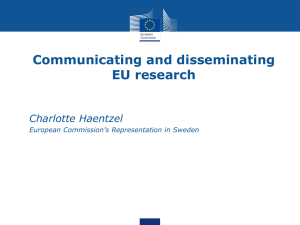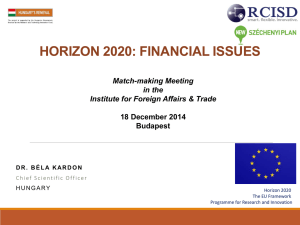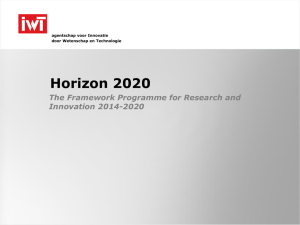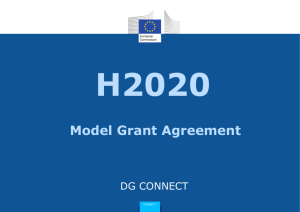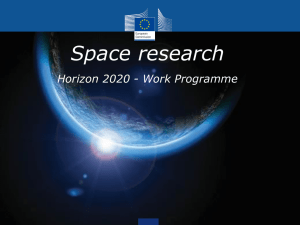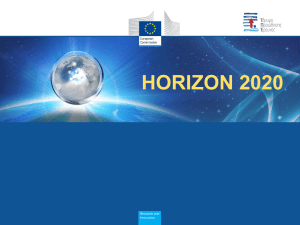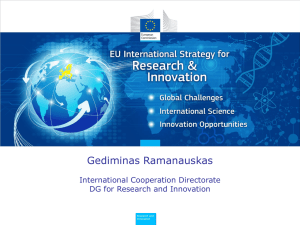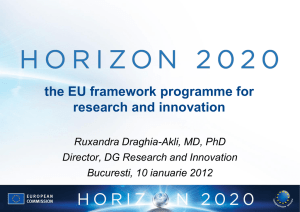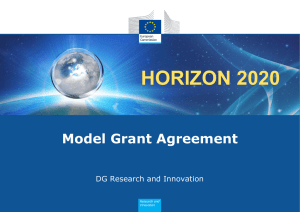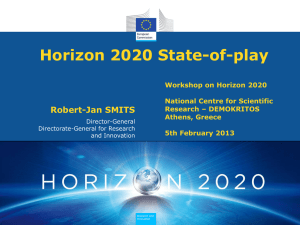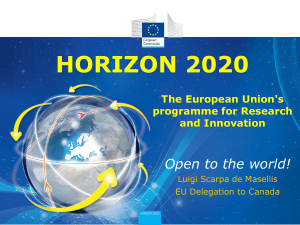Commission`s proposal for HORIZON 2020 Rules for Participation
advertisement
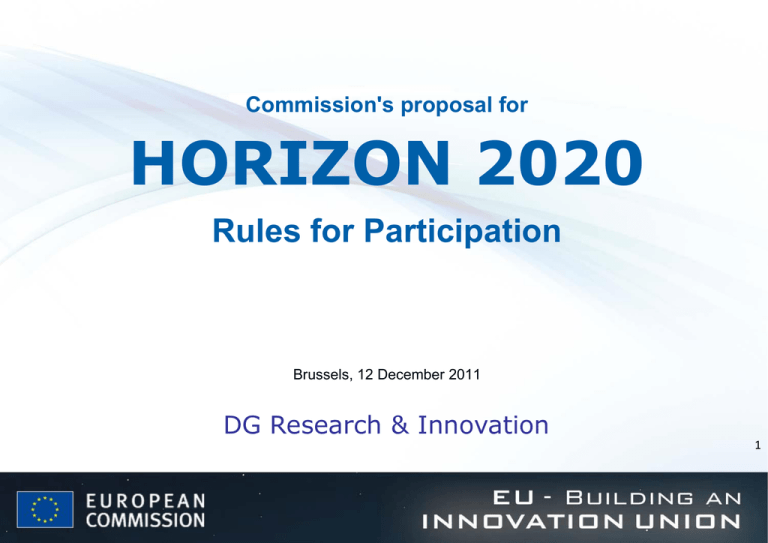
Commission's proposal for HORIZON 2020 Rules for Participation Brussels, 12 December 2011 DG Research & Innovation 1 HORIZON 2020 Rules for Participation Stakeholders consultations Horizon 2020 Rules for participation are built upon the outcome of an extensive consultation with authorities and stakeholders, including: Green Paper on a Common Strategic Framework: public consultation * From 9 February 2011 to 20 May 2011: 775 position papers received ranging from Ministries to individual participants; over 1300 on-line replies Impact assessment: on-line survey on administrative costs and baseline scenario for Horizon 2020 * From 11 February 2011 to 4 March 2011: nearly 3900 replies from all type of beneficiaries Meetings and workshops with stakeholders * 4-5 April 2011: meeting with the National Contact Points (NCPs) * 28 April 2011: Stakeholders Workshop on Simplification and Intellectual Property Rights 2 HORIZON 2020 Rules for Participation Stakeholders consultation Some key messages from the stakeholders REDUCE INCREASE Different sets of rules Trust Administrative burden Reliance on the usual accounting practices Complexity Excessive controls Time-to-grant Time-to-pay Consistency in the application of the rules Innovation New forms of funding (eg. prizes, output based, etc) MAINTAIN & IMPROVE Reimbursement of real costs as the main funding mode Basic IPR orientations and level of detail of their rules Simplification measures Funding levels Other successful elements of FP7 3 HORIZON 2020 Rules for Participation Objectives Innovation RfP Horizon 2020 Coherence Simplification 4 A glance on the Commission's proposal 1. A SINGLE SET OF RULES: the overarching principle SINGLE SET OF RULES for Horizon 2020 • Covering all research programmes and funding bodies (art.185 initiatives, art. 187 initiatives, CIP, EIT)… EU Financial Regulation …but flexible to accommodate specificities where needed. • In accordance with the new Financial Regulation and its Delegated Act. • Coherent with the rules of the other EU programmes. • Also applicable to Euratom. …ETC 5 A glance on the Commission's proposal 2. SINGLE FUNDING RATE FOR DIRECT COSTS Maximum reimbursement rates Research and technological development activities (*) Network of excellence 50% 75% (**) Collaborative project(****) 50% 75% (**) Coordination and support action Demonstration activities Other activities 100% 50% One project = One rate Same rate for all beneficiaries and all activities in the grant. The applicable rate will be defined in the Work Programme: 100% 100% (***) (*) Research and technological development includes scientific coordination. (**) For beneficiaries that are non-profit public bodies, secondary and higher education establishments, research organisations and SMEs (***) The reimbursement of indirect eligible costs, in the case of coordination and support actions, may reach a maximum 7% of the direct eligible costs, excluding the direct eligible costs for subcontracting and the costs of resources made available by third parties which are not used on the premises of the beneficiary. (****) Including research for the benefit of specific groups (in particular SMEs) Up to 100 % of the eligible costs; but limited to a maximum of 70 % for projects “close to market”. 6 A glance on the Commission's proposal 3. FORMS OF FUNDING What would remain from Grant Agreements as the main funding stream (also possibility of Grant Decisions). Reimbursement of costs as the main funding method. What would be Specific provisions for new forms of funding targeting innovation: precommercial procurement, procurement of innovative solutions and inducement prizes. Financial instruments: a debt financial instrument, a financial instrument providing equity finance for R&I, etc. Possibility of output-based grants (lump-sums per project). Enhanced use of other lump-sums, flat rates and scales of unit. 7 A glance on the Commission's proposal 4. COST REIMBURSEMENT PERSONNEL COST Wider acceptance of average personnel costs (now under scale of unit costs) Minimizing in Horizon 2020 the basic conditions for acceptance of average personnel cost accounting practices (including cost-centre approaches). Simplifying participation for SMEs Providing in the Rules for a scale of unit system for SME owners and physical persons without a salary. Less requirements for time records No time records for researchers working exclusively in the project. …and more in the Horizon 2020 Grant Agreement The Grant Agreement will add further elements of simplification regarding personnel costs like simplified provisions on productive hours and clear minimum rules on time-recording. INDIRECT COSTS Unique method: 20 % flat-rate Aiming at simplifying the financial rules and reducing the recurrent errors in the calculation of the indirect costs, frequently leading to liquidated damages and extrapolation. 8 A glance on the Commission's proposal 5. CONTROLS AND AUDITS Financial viability Most beneficiaries exempt from detailed analysis; only systematic check for coordinators when requested EU funding for the project is ≥ 500 k€ Audit certificates Only for final payments when total EU contribution claimed by the beneficiary on the basis of actual costs ≥ 325.000 € Optional Certificates on average personnel costs (now under scale of unit costs) Attention: The provisions are in Horizon 2020 Regulation ! Ex-post audits Audit strategy focused on risk and fraud prevention In the path to a single representative sample Extrapolation New Financial Regulation will apply Guarantee Fund Continuity of the system under procedures similar to those applied in FP7 9 A glance on the Commission's proposal 6. INTELLECTUAL PROPERTY RIGHTS The rules on IPR, exploitation and dissemination of results are built on the basis of proven FP7 provisions with an appropriate balance between legal security and flexibility. Basic orientations: Results: Ownership for the participant that generates the result, joint-ownership where jointly generated (default regime: fair and reasonable compensation in case of transfer). Results must be disseminated and best effort obligation to exploit; work programmes/grant agreements can foresee specific exploitation obligations (Art 40 (1) – recital 19). Transfer: right to object to transfer outside the EU/AC will be maintained(41 (3)). Access rights: For participants for implementation and for exploitation purposes. For the EU for non-commercial, policy purposes. Specific cases – to be addressed in the Grant Agreement: security-related activities, ERC frontier research, mobility, etc. 10 A glance on the Commission's proposal 6. INTELLECTUAL PROPERTY RIGHTS (II) Further measures and improvements added in the Commission's proposal for Horizon 2020 Rules for Participation include: Flexible provisions for the new forms of funding (pre-commercial procurement, procurement of innovative solutions, etc). A new emphasis on open access to research publications (Art. 40 (2)). 11 Thank you very much for your attention! 12

